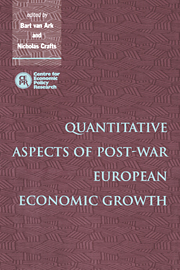Book contents
- Frontmatter
- Contents
- List of figures
- List of tables
- List of contributors
- Preface
- 1 Catch-up, convergence and the sources of post-war European growth: introduction and overview
- 2 Macroeconomic accounts for European countries
- 3 Sectoral growth accounting and structural change in post-war Europe
- 4 Measures of fixed capital stocks in the post-war period: a five-country study
- 5 Technology indicators and economic growth in the European area: some empirical evidence
- 6 Human capital and productivity in manufacturing during the twentieth century: Britain, Germany and the United States
- 7 Convergence and divergence in the European periphery: productivity in Eastern and Southern Europe in retrospect
- 8 Convergence: what the historical record shows
- 9 Growth and convergence in OECD countries: a closer look
- 10 On the historical continuity of the process of economic growth
- 11 Europe's Golden Age: an econometric investigation of changing trend rates of growth
- Index
9 - Growth and convergence in OECD countries: a closer look
Published online by Cambridge University Press: 23 December 2009
- Frontmatter
- Contents
- List of figures
- List of tables
- List of contributors
- Preface
- 1 Catch-up, convergence and the sources of post-war European growth: introduction and overview
- 2 Macroeconomic accounts for European countries
- 3 Sectoral growth accounting and structural change in post-war Europe
- 4 Measures of fixed capital stocks in the post-war period: a five-country study
- 5 Technology indicators and economic growth in the European area: some empirical evidence
- 6 Human capital and productivity in manufacturing during the twentieth century: Britain, Germany and the United States
- 7 Convergence and divergence in the European periphery: productivity in Eastern and Southern Europe in retrospect
- 8 Convergence: what the historical record shows
- 9 Growth and convergence in OECD countries: a closer look
- 10 On the historical continuity of the process of economic growth
- 11 Europe's Golden Age: an econometric investigation of changing trend rates of growth
- Index
Summary
Introduction
Economic integration among European countries is expected to bring about faster average growth. Less advanced countries hope to narrow the gap with the richer ones in terms of per capita income. However, whether or not this distributional effect will work is still an open question. From a theoretical viewpoint, growth theory is the appropriate framework to deal with these issues. In the long run, two basic features determine a country's economic achievements. One is the preferences of households, firms and governments for current consumption as opposed to future consumption. The other is the technological capability (in a broad sense) of the society to use the resources not devoted to current consumption.
In this chapter we carry out an empirical analysis of convergence patterns among the OECD countries, which satisfy reasonably well the traditional hypothesis of neoclassical growth models: they present a sustained growth of income per capita from the 1950s onwards, welldeveloped markets for production factors and relatively constant saving rates. We check the robustness of the main parameters in the constant returns to the scale Solow model under alternative specifications and estimation procedures. We also analyse the stability of the model (in particular the convergence rate) over time and across country groups.
Convergence regressions are carried out in the way popularized by Barro and Sala-i-Martin (1991) and Mankiw et al (1992), MRW hereafter, among others. Our interest is not merely to assess whether or not convergence has taken place, but also to see whether the long-run evolution of these economies can be explained in the theoretical framework of the Solow (1956) model.
- Type
- Chapter
- Information
- Quantitative Aspects of Post-War European Economic Growth , pp. 347 - 387Publisher: Cambridge University PressPrint publication year: 1997



